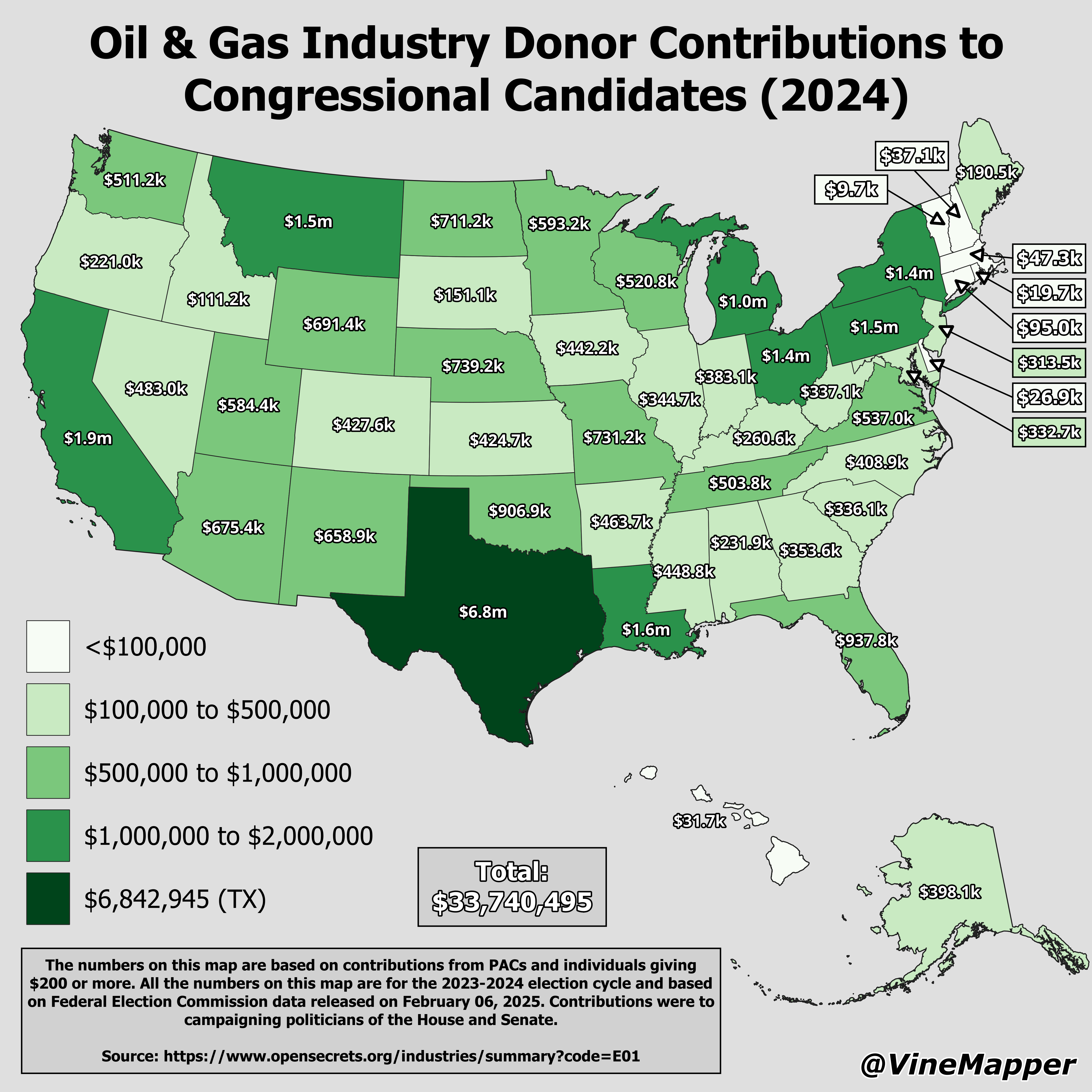Oil & Gas Industry Donor Contributions Map 2024


Marcus Rodriguez
Historical Geography Expert
Marcus Rodriguez specializes in historical cartography and geographic data analysis. With a background in both history and geography, he brings unique...
Geographic Analysis
What This Map Shows
The map titled "Oil & Gas Industry Donor Contributions to Congressional Candidates (2024)" provides a clear visualization of the financial support that candidates in the upcoming congressional elections are receiving from the oil and gas sector. It illustrates how contributions are distributed across various congressional districts, highlighting the relationships between the energy industry and political candidates vying for office. This visualization is crucial as it reveals the influence of energy sector funding on political campaigns, which can ultimately impact legislation and policies regarding energy production, environmental regulations, and climate change initiatives.
Deep Dive into the Oil & Gas Industry Contributions
The oil and gas industry plays a significant role in the U.S. economy, contributing billions in revenue and providing millions of jobs. However, its influence extends beyond economics; it also reaches into politics. The financial contributions made by this industry to congressional candidates can shape policy decisions that affect everything from drilling regulations to environmental protections.
In 2024, as we approach a pivotal election year, the contributions from the oil and gas sector are expected to be substantial. Interestingly, the contributions are not uniformly spread across the country; they tend to cluster in regions with significant oil and gas reserves or established industry presence. For instance, states like Texas, North Dakota, and Louisiana are often at the forefront of donor contributions due to their robust oil and gas industries. In fact, Texas alone accounts for a significant percentage of total contributions, reflecting the state's entrenched relationship with energy production.
Moreover, these contributions can vary dramatically depending on the political landscape. Candidates from regions heavily reliant on the oil and gas sector may receive more substantial donations compared to those from areas where renewable energy sources are more prevalent. This financial backing is often aimed at candidates who support pro-oil policies, such as deregulation efforts and tax breaks for fossil fuel companies, which can lead to increased production and exploration activities.
Interestingly, this dynamic raises questions about the long-term implications of such financial influences. Have you noticed how some congressional districts have seen an influx of campaign contributions leading up to election time? This correlation can create a feedback loop where increased funding results in favorable legislation for the industry, which in turn generates even more funding for future campaigns.
Regional Analysis
When examining the map, it becomes evident that certain regions are more heavily influenced by oil and gas contributions. The Gulf Coast states, particularly Texas and Louisiana, stand out with significant donor activity. For example, Texas has a long-standing history of oil production, and this is reflected in the contributions made to congressional candidates from the state. In contrast, states such as California, which are more focused on renewable energy, show lower contributions from the oil and gas sector.
In the Midwest, states like North Dakota have seen a surge in contributions as fracking has transformed the local economy. Candidates from these regions are often backed by substantial donations, which can influence their stance on energy policies. Conversely, candidates in states that prioritize environmental sustainability may receive less support from oil and gas donors, reflecting a broader ideological divide in American politics.
Additionally, the map may reveal emerging trends in donor contributions. For example, as the push for renewable energy gains momentum, there may be a shift in contributions towards candidates who advocate for a balanced energy policy that includes both fossil fuels and renewables. Observing these patterns can provide valuable insights into the future of energy policy in the U.S.
Significance and Impact
Understanding the relationship between the oil and gas industry's contributions to congressional candidates is crucial, especially in the context of current environmental challenges. As the U.S. grapples with climate change and seeks to transition towards more sustainable energy sources, the influence of these contributions could have profound implications for policy directions.
What’s fascinating is that while the oil and gas industry continues to wield significant power through financial contributions, there is a growing counter-movement advocating for climate action and renewable energy investments. This tension between traditional energy sources and emerging sustainable practices will play a crucial role in shaping the 2024 elections.
As we move closer to the elections, observing how these contributions influence candidate platforms and voter sentiment will be key. The interplay between donor funding and legislative outcomes can potentially change the landscape of energy policy in the U.S., affecting everything from job creation in the renewable sector to environmental safeguarding initiatives. It’s a complex web that connects money, politics, and the future of energy in America.
In conclusion, the map displaying the oil and gas industry’s donor contributions to congressional candidates offers a window into the powerful intersection of energy and politics. By analyzing these contributions, we can better understand the potential implications for future legislation and the ongoing dialogue about energy sources in the U.S.
Visualization Details
- Published
- October 12, 2025
- Views
- 34
Comments
Loading comments...